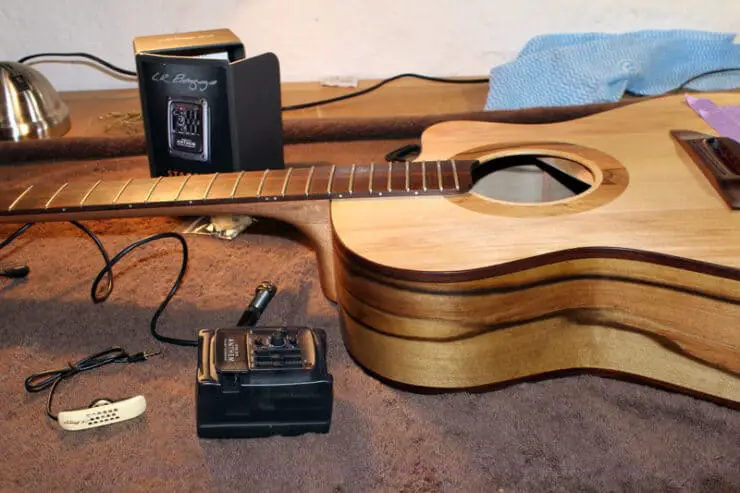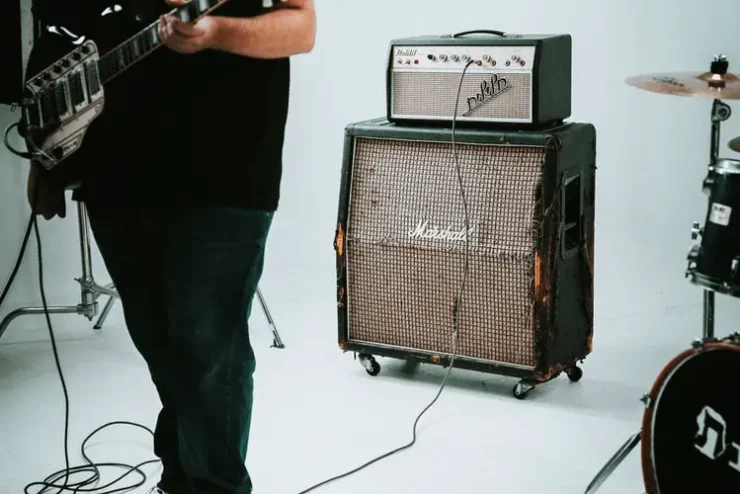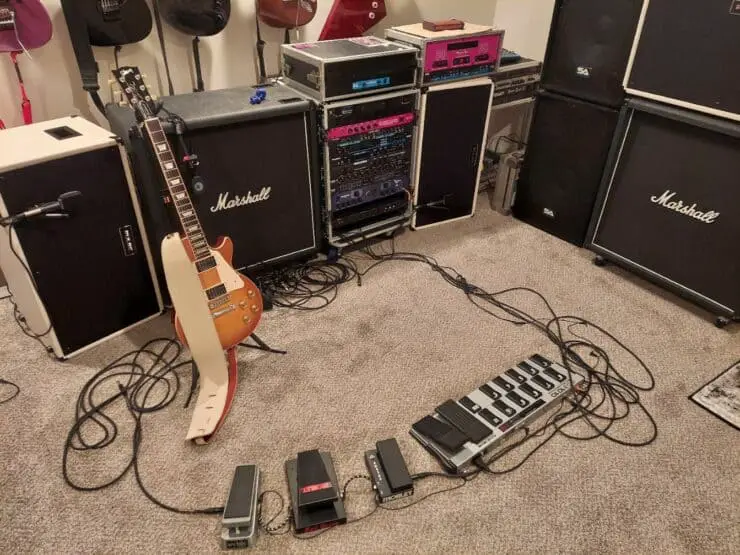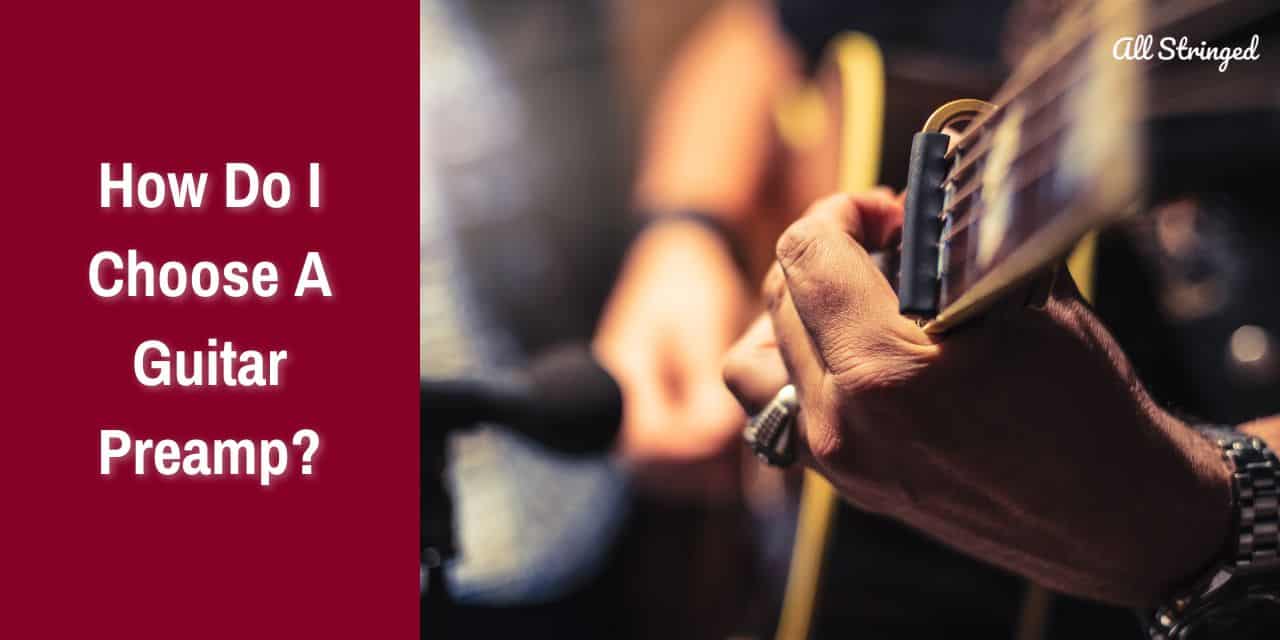Welcome, guitar players! Are you looking for advice on choosing a preamp for your guitar? Preamps are a crucial part of any guitar rig, and it’s important to make sure you have the right one for your needs. In this article, we will discuss the factors to consider when selecting the best preamp for your guitar. We will take a look at different types of preamps, discuss the role of a preamp in the guitar rig, and explore various features. So, read on if you are ready to learn all about guitar preamps!
Overview of a guitar preamp
A guitar preamp is a key component in the signal chain of an electric guitar or bass setup. It is responsible for amplifying the weak electrical signal generated by the guitar pickups and preparing it for further amplification or processing. A guitar preamp plays a vital role in shaping the tone and enhancing the sound of the instrument.
The functionality of a guitar preamp
A preamplifier or simply known as a preamp is an electronic device that amplifies a low-level signal to a level suitable for further processing or amplification. In the context of a guitar, the preamp is typically built into the guitar amp or can be a standalone unit. It serves as the initial stage of amplification for the guitar signal before it reaches the power amp section.
The primary function of a guitar preamp is to boost the weak electrical signal generated by the pickups of an electric guitar or bass. Pickups are basically magnets wrapped in coils of wire that capture the vibrations of the strings and convert them into an electrical signal. However, the signal produced by the pickups is relatively low in amplitude and requires amplification to be audible.
>>> Click here to read our review about the Top 15 Best Guitar Preamps <<<
In addition to amplifying the signal, a guitar preamp also shapes the tone by adjusting various parameters. It typically features controls such as gain, equalization (EQ), volume, and tone. These controls allow guitarists to shape the character, color, and overall sound of their instrument. By adjusting the gain, the players will be able to achieve a clean, pristine sound, or dial in various levels of overdrive or distortion for a grittier tone.
Importance of a guitar preamp
The guitar preamp plays a key role in the overall sound and tone of an electric guitar or bass. It provides the initial amplification and tone-shaping capabilities that lay the foundation for the final sonic result. Whether it is adding warmth and color with a tube preamp, achieving pristine clarity with a solid-state preamp, or exploring a multitude of sounds with a modeling preamp, the choice of the preamp can influence the musical expression and creativity of a guitarist.
Further, a guitar preamp can offer additional features and functionalities like built-in effects, Direct Input (DI) capabilities for recording or live sound, and tone sculpting options specific to certain musical genres. It’ll allow the guitarist to tailor their sound to suit their playing style, musical genre, and personal preferences.

Benefits of using a guitar preamp
A guitar preamp offers an impressive range of benefits that can significantly impact the overall tone, versatility, and performance capabilities of an instrument. Here are some of the benefits of using a guitar preamp and how it can elevate your playing experience.
#1. Amplifies the signal
One of the major benefits of a guitar preamp is its ability to amplify the weak electric signals produced by the pickups. This ensures that the signal is strong enough to be processed and amplified further by the power amp section of an amplifier or audio interface. With a preamp, you’ll be able to achieve a higher signal level, which translates to improved clarity, dynamics, and overall volume.
#2. Tone shaping and controls
Guitar preamps offer a wide variety of tone-shaping options that allow you to sculpt your instrument’s sound. Most preamps feature controls such as gain, EQ, volume, and tone knobs, allowing you to adjust the frequency response and characteristics of your guitar’s signal. This versatility empowers you to create a wide range of tones, from clean and pristine to gritty and distorted, catering to different musical genres and playing styles.
#3. Offers tremendous versatility and flexibility
A guitar preamp offers incredible versatility and flexibility in terms of the tonal possibility it offers. Depending on the type of preamp you are choosing, you’ll be able to access various tonal flavors and textures.
Tube preamps offer warm, vintage tones with natural compression. Solid-state preamps are capable of delivering clean and transparent sounds. Modeling preamps offer extensive options for emulating different amplifiers and effects combinations. This versatility will allow you to explore various sonic landscapes and adapt to different musical contexts.
#4. Consistency in sound
Using a guitar preamp ensures consistency in your tone, regardless of the amp or audio system you connect to. By having more control over the initial amplification and tone-shaping stages, you’ll be able to maintain a consistent sound signature throughout different performance environments. This is especially beneficial for gigging musicians who might encounter various sound systems or venues where their gear needs to be adapted.
#5. Integrated with effects and recording
Guitar preamps often include additional features like built-in effects, DI capabilities, and headphone outputs. This integration will allow you to experiment with different effects like reverb, delay, modulation, and more, without needing additional pedals. DI outputs enable direct connection to audio interfaces or mixing consoles for recording or live sound applications, bypassing the requirement for microphones. These features offer convenience, cost-effectiveness, and flexibility in expanding your sonic possibilities.

#6. Portability and convenient to carry
For guitarists who are frequently on the go or those who prefer a compact setup, standalone guitar preamps offer a portable and convenient solution. They can be easily incorporated into pedalboards, recording setups, or live rigs, allowing you to carry your preferred tone wherever you go. Moreover, using a preamp can simplify the setup process by reducing the number of components and cables needed.
Different types of guitar preamps
A guitar preamp is a vital component in the signal chain of an electric guitar or bass setup. It amplifies the weak electrical signal generated by the pickups and shapes the tone before it is sent to the power amp. There are different types of guitar preamps available, each with its own characteristics and sonic qualities. Here are the different types of guitar preamps and their unique features.
#1. Tube preamps
Tube amps use vacuum tubes for amplifying the guitar signal. This type of amp is highly regarded among musicians as it produces a warm, organic, and vintage tone.
Tube preamps add a certain richness, harmonics, and natural compression to the sound, making them popular among musicians and guitarists who prefer a classic, vintage vibe. They can deliver smooth, clean tones and rich, overdriven, and distorted tones when pushed. Tube preamps are often associated with genres like rock, jazz, and blues.
#2. Solid-state preamps
Solid-state preamps utilize transistors and other solid-state components for amplification. They offer a clean, transparent, and accurate representation of the guitar signal without adding coloration or distortion. Solid-state preamps are known for their reliability, durability, and consistent performance.
These amps provide a wide frequency response and can handle high-gain settings effectively, making them suitable for various musical genres and playing styles. Solid-state preamps are commonly found in modern guitar amps and are often preferred by musicians looking for clarity and precision in their tone.
#3. Digital modeling preamps
Digital modeling preamps are a rather recent innovation in the world of guitar amplification. Such preamps utilize digital technology for replicating the sounds of different amplifiers, cabinets, and effects. They offer an extensive range of tonal options and allow guitarists to access an impressive variety of iconic amp models and effects with a single unit.
Modeling preamps often come bundled with a wide selection of presets, allowing the musician or guitarist to dial in the tones of famous vintage and modern amps. They are particularly popular among recording musicians and those who need a versatile and portable solution for live performances.
#4. Hybrid preamps
Hybrid preamps manage to combine the best of both worlds, tube amps and solid-state amps. They typically feature a tube-driven preamp stage combined with solid-state circuitry for power amplification.
This hybrid design aims to provide the warmth and character of tubes while still maintaining the reliability and efficiency of solid-state components. Hybrid preamps offer a balance between vintage warmth and modern versatility, which makes them suitable for a wide range of musical styles.
#5. Rack-mounted preamps
Rack-mounted preamps are designed to be mounted in a standard equipment rack. This type of preamp is commonly used in professional studio setups or live performance rigs. They often feature multiple channels, comprehensive control options, and advanced connectivity for seamless integration with other audio equipment. Rack-mounted preamps offer professional-grade signal processing and tone-shaping capabilities, offering extensive flexibility and control over the guitar signal.
#6. Pedalboard preamps
Pedalboard preamps are compact, stompbox-sized units that can be easily incorporated into a guitarist’s pedalboard setup. This type of preamp often includes additional features like built-in effects, amp modeling, and speaker simulation. They allow guitarists to access a wide array of tones and effects in a compact and portable format. Pedalboard preamps are popular among gigging musicians who require a versatile and travel-friendly solution.
How do I choose a guitar preamp?
Choosing the right guitar preamp will be important for achieving your designed tone and enhancing your playing experience. With the wide variety of preamps available on the market, it’ll be important to test and evaluate them before making a purchase. Here are the steps you’ll need to follow when choosing a guitar preamp.
Listen to sound sounds
Many manufacturers and retailers provide sound samples of their guitar preamps, either on their websites or through online platforms. These samples can give you a sense of the preamp’s sonic characteristics and its ability to produce various tones. To make the most of listening to sound samples and choose the best guitar preamp, you’ll need to consider your musical style, check for versatility, analyze the tone quality, and pay attention to effects.
You must look for sound samples that match your preferred musical style. If you’re playing blues, listen for warm and expressive tones. If you play metal, check for aggressive and high-gain sounds. Match the preamp’s sound samples to your genre as it’ll give you a better idea of its suitability for your musical needs.
You should also listen to a variety of sound samples for gauging the preamp’s versatility. Pay close attention to how well it handles different playing styles, genres, and tonal variations. Assess whether it is able to deliver the clean tones, overdrive, distortion, or crunch that you desire.
Focus on the overall tone quality in the sound samples. Evaluate factors such as clarity, presence, dynamics, and tonal balance. Assess whether the preamp provides the desired level of definition and articulation or if it sounds muddy or harsh.
If the preamp includes modeling capabilities or built-in effects, listen carefully to how these effects sound in the samples. Evaluate the quality and authenticity of the effects and their usability for your playing style.
Test the preamp in person
While listening to sound samples can offer useful insights, there is nothing quite like testing a guitar preamp in person. To test the preamp in person, you’ll need to carry out a set of steps.
First, you must bring your own guitar to the store or demo event so that you can assess how the preamp interacts with your specific instrument. This will give you a more accurate representation of the tone and response you can expect when using the preamp in your setup.
Spend some time exploring various controls and settings of the preamp. Adjust the gain, EQ, volume, and other parameters to see how they affect the tone. Test the preamp’s ability to produce a range of clean, crunch, and distorted tones that suit your playing style.
If possible, you should try the preamp with different amps and speakers to evaluate its compatibility and sound characteristics across various setups. This will help you determine if the preamp complements your existing gear or if it requires specific components to achieve the desired tone.
Take note of the preamp’s build quality, user interface, and additional features. You need to consider factors like ease of use, durability, and the presence of essential features like headphone outputs, direct recording outputs, or effects loops.
Ultimately, you’ll need to test your own ears and instincts. Pay close attention to how the preamp feels and sounds as you play. Focus on factors like responsiveness, touch sensitivity, and overall enjoyment. If it inspires you to play and brings out the best in your instrument, it might be the perfect choice for you.

Budget considerations to make when choosing a guitar amp
When it comes to choosing a guitar preamp, the budget will be an important factor for many musicians and guitarists. Preamps can vary significantly in price and it is important to weigh your options carefully. One aspect to consider is whether or not to buy a new or used preamp. Moreover, you’ll also have to account for the cost of accessories that might be needed for proper functionality. Here are the budget considerations you’ll need to make when choosing a guitar amp and the expenses to keep in mind.
New preamps
New preamps often come with a manufacturer’s warranty, giving you peace of mind in case of any defects or malfunctions. Moreover, manufacturers typically offer customer support and assistance for any inquiries or issues you might encounter.
Buying a new preamp will allow you to access the newest features, technology, and advancements in the market. You’ll be able to take full advantage of improved circuitry, enhanced sound quality, additional connectivity options, and updated firmware.
With a new preamp, you can be confident in its condition and reliability. There is no need to worry about wear and tear, previous misuse, or potential hidden problems that might come with a used unit.
Investing in a new preamp might offer you a longer lifespan as you’re starting with a fresh and unused unit. This can be especially important if you plan on using the preamp extensively or if you rely on it for professional purposes.
However, buying a new preamp comes at a significantly higher price compared to a used one. It is important to assess your budget and determine if the additional expense is justifiable based on your needs and preferences.
Used preamps
Opting for a used preamp is a cost-effective solution and it comes with numerous benefits. Used preamps tend to be more affordable than new guitar preamps. You can easily find great deals on preamps that are in good condition, allowing you to save a significant amount of money.
Buying used preamps will give you the opportunity to access vintage or discontinued models that might no longer be available as new. These preamps often come with unique characteristics and can be highly sought after by certain musicians.
Some musicians believe that older preamps possess a certain character and tonal quality that is desirable for their specific playing style or music genre. Used preamps often offer a vintage vibe or a particular sonic signature that might be appealing to you. If a specific preamp model is no longer in production, your only option might be to search for a used unit. This widens your choices while allowing you to explore a broader range of preamps.
However, it is important to consider that buying a used preamp also comes with a few potential risks. To tackle such issues, you should first ensure that you’ve thoroughly evaluated the condition of the preamp before buying it. Look for any signs of damage, wear, or malfunction. Ask the seller detailed questions about the unit’s history, maintenance, and past issues.
Used preamps might not necessarily come with a warranty and you might not have access to the same level of customer support as with a new preamp. It is important to consider this trade-off and assess your comfort level with potential repairs or servicing.
Cost of accessories
In addition to the preamp itself, it is important to factor in the cost of accessories that might be needed for proper functionality. You should factor in things like power supply, cables and connectors, and mounting hardware.
Determine if the preamp needs a specific power supply or adapter. Some preamps come with their own power supply whereas others might require a separate purchase. You should also consider the type and lengths of cables needed for connecting the preamp to the amps, effects pedals, or recording equipment. You need to budget for high-quality cables to ensure optimal signal transmission and minimize noise interface.
If you’re planning to rack-mounted the preamp, you should check if any specific mounting brackets or hardware are needed. These additional components should be accounted for in your budget.
FAQs
What should I consider when choosing a guitar preamp?
When choosing a guitar preamp, you should consider the type of guitar and playing style, the features and controls available, the size and weight of the preamp, the power requirements, and the budget. It’s important to find the right balance of these factors to ensure you get a preamp that meets your needs and produces the sound you are looking for.
What are the benefits of using a preamp?
Using a preamp can provide several benefits, including improved tone and sound quality, better signal processing, and more control over the sound. Preamps can also allow you to shape the sound of your guitar in more creative ways, allowing you to add effects and other sonic characteristics to your sound.
What type of preamp should I use for my guitar?
The type of preamp you should use for your guitar depends on the type of guitar and playing style, as well as your own needs and preferences. Generally speaking, tube preamps are known for their warm, dynamic sound, while solid state preamps are known for their clarity and accuracy. Modeling preamps offer the ability to simulate classic amp tones and create unique sounds. Ultimately, it’s up to you to decide which type you want to go for.



